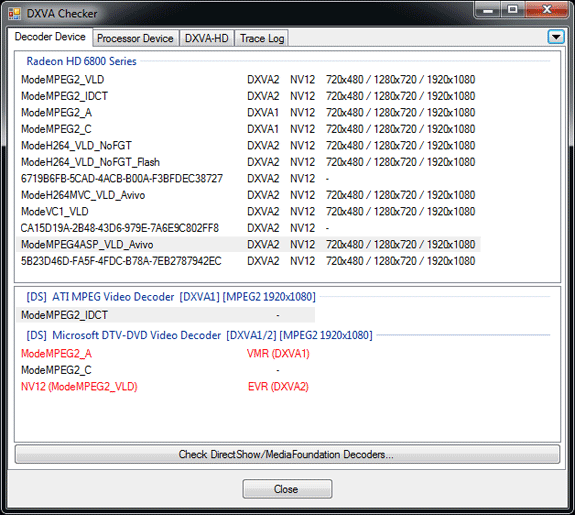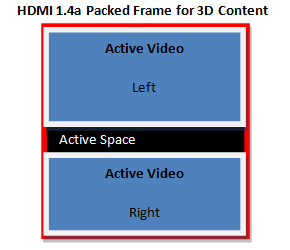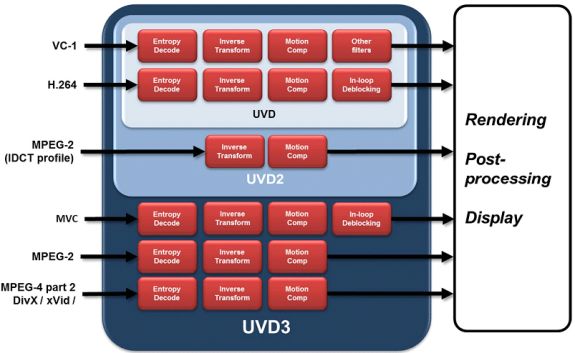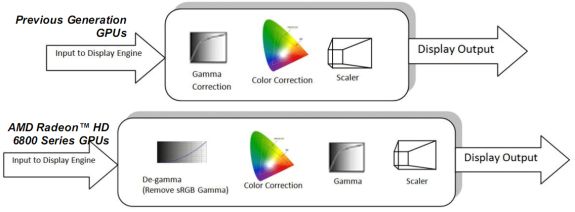AMD’s Radeon HD 6870 & 6850: Renewing Competition in the Mid-Range Market
by Ryan Smith on October 21, 2010 10:08 PM ESTSeeing the Present: HDMI 1.4a, UVD3, and Display Correction
DisplayPort wasn’t the only aspect of AMD’s display controller that got an overhaul however, AMD’s HDMI capabilities have also been brought up to modern standards. Coming from Cypress with support for HDMI 1.3, AMD now supports HDMI 1.4a on the Barts based 6800 series and presumably they will do so on the rest of the 6800 series too. With HDMI 1.4a support AMD can now support full resolution (1080p) 3D stereoscopy for movies, and 720p for games and other material that require 60Hz/eye, along with 4k x 2k resolution for monitors and TVs that have equivalent support. Unlike DP this has less to do with monitors and more to do with TVs, so the importance of this will be seen more on future AMD cards when AMD refreshes their lower-end parts that we normally use with HTPCs.
Launching alongside support for displaying full resolution 3D stereoscopic video is the hardware necessary to decode such video, in the form of the latest version of AMD’s Unified Video Decoder: UVD3. The last time UVD received a major update was with UVD2, which launched alongside the Radeon HD 4000 series and added partial MPEG-2 decoding support by moving IDCT and MoComp from shaders in to the UVD fixed function hardware.
With the Radeon 6800 series AMD is releasing UVD3, which like UVD2 before it builds on the existing UVD feature set. UVD3 is adding support for 3 more-or-less new codecs: MPEG-2, MVC, and MPEG-4 ASP (better known as DivX/XviD). Starting with MPEG-4 ASP, it’s the only new codec in supported by UVD3 that’s actually new, as previously all MPEG-4 ASP decoding was done in software when it came to AMD GPUs. With UVD3 AMD can now completely offload MPEG-4 ASP decoding to the GPU, bringing forth the usual advantages of greatly reducing the amount of work the CPU needs to do and ideally reducing power consumption in the process.
AMD adding MPEG-4 ASP support gives us an interesting chance to compare and contrast them to NVIDIA, who added similar support a year ago in the GT21x GPUs. AMD is a good bit behind NVIDIA here, but they’re making up for it by launching with much better software support for this feature than NVIDIA did; NVIDIA still does not expose their MPEG-4 ASP decoder in most situations, and overall did a poor job of advertising it. When we talked with DivX (who is AMD’s launch partner for this feature) they didn’t even know that NVIDIA had MPEG-4 ASP support. Meanwhile AMD is launching with DivX and had a beta version of the DivX codec with UVD3 support ready to test, and furthermore AMD is fully exposing their MPEG-4 ASP capabilities in their drivers as we see in this DXVA Checker screenshot.

The only downside at this time is that even with Microsoft’s greater focus on codecs for Windows 7, Windows 7 doesn’t know what to do with DXVA acceleration of MPEG-4 ASP. So while Win7 can play MPEG-4 ASP in software, you’re still going to need a 3rd party codec like the DivX codec to get hardware support for MPEG-4 ASP.
The other bit worth mentioning is that while AMD is launching support for MPEG-4 ASP decoding here on the 6800 series, much like HDMI 1.4a it’s not going to be a big deal for the 6800 series market. MPEG-4 ASP is a fairly lightweight codec, so support for it is going to be a bigger deal on low-end products, particularly AMD’s APUs if Llano and Bobcat end up using UVD3, as MPEG-4 ASP decoding in software requires a much greater share of resources on those products.
Up next is MPEG-2, which has been a codec stuck in limbo for quite some time over at AMD. MPEG-2 is even older and easier to decode than MPEG-4 ASP, and while GPUs have supported MPEG-2 decode acceleration as early as last decade, CPUs quickly became fast enough that when combined with low levels of hardware decode acceleration (inverse discrete cosine transform) was more than enough to play MPEG-2 content. Thus AMD hasn’t done much with MPEG-2 over the years other than moving IDCT/MoComp from the shaders to UVD for UVD2.
Because of the similarities between MPEG-4 ASP and MPEG-2, when AMD added support for full MPEG-4 ASP decode acceleration they were able to easily add support for full MPEG-2 decode acceleration, as they were able to reuse the MPEG-4 ASP entropy decode block for MPEG-2. As a result of including full MPEG-4 ASP decode acceleration, AMD now supports full MPEG-2 decode acceleration. Even more so than MPEG-4 ASP however, the benefits for this are going to lie with AMD’s low-end products where getting MPEG-2 off of the CPU should be a boon for battery life.

The final addition to UVD3 is support for Multiview Video Coding, which isn’t a new codec per se, but rather is an extension to H.264 for 3D stereoscopy. H.264 needed to be amended to support the packed frame formats used to store and transmit 3D stereoscopic videos, so with UVD3 AMD is adding support for MVC so that UVD can handle Blu-Ray 3D.
Finally, coupled with support for new codecs and new display outputs in AMD’s display controller is a refinement of AMD’s existing color correction capabilities in their display controller. Cypress and the rest of the 5000 series could do color correction directly on their display controllers, but they could only do so after gamma correction was applied, meaning they had to work in the non-linear gamma color space. Technically speaking this worked, but color accuracy suffered as a result. With the 6800 series’ new display controller, AMD can now perform color calibration in linear space by converting the image from gamma to linear color space for the color correction, before converting it back to gamma color space for display purposes.
As color correction is being used to correct for wide-gamut monitors the importance of this change won’t be seen right away for most users, but as wide-gamut monitors become more widespread color correction becomes increasingly important since wide-gamut monitors will misinterpret the normal sRGB colorspace that most rendering is done in.












197 Comments
View All Comments
529th - Saturday, October 23, 2010 - link
the marketers wanted to differentiate themselves from Nvidia, that's why they are using their second place cards to be in the same category as nvidias second place cardsIf you are shopping for a top of the line card you should know atleast a little bit about them although the un-educated video-card shopper would think that a 470 and 5870 or 6870 is on the SAME performance level, WHICH ISN'T TOO FAR FROM THE TRUTH, but I think it's here where AMD marketers are trying to make a statement
i could be wrong, i have had very little sleep last night, cedar point was a blast!
SininStyle - Saturday, October 23, 2010 - link
Can I just say THANK YOU for adding a OC edition of the 460. Don't know why everyone is whining. If you don't want to know how an OC edition compares then ignore the stupid bench for it. Why is such a huge deal?I personally am glad they included it and this is why. The 460 1gb stock is 675mhz and can OC "reliably" to 850mhz.. That's 175mhz gain and its noticeable. Stock volt stock fan. And for those that wanna claim heat, mine shows 64c at 75% fan on OCCT. The 6870 get 50hz OC at stock volt/fan. SEE why this is important people? $180 vs $240 with same results.
Now with volt changes I'm sure they both have room to go I'm not sure how much. I tend to shy away from higher voltages at least for now.
The 6850 is the better buy between the 2 68xx cards. That has allot of headroom to OC. That would even be a better comparison to the 460 due to the price. And owning the 460 doesn't make me a fanboy and I will say you can flip a coin for value on these 2.
So again thanks for the added information. Cant see why anyone would complain about more info. If you don't like the info ignore it if it makes you feel better. Feel free to add OCed 6850s and 6870s I look forward to the comparison.
Parhel - Saturday, October 23, 2010 - link
"The 460 1gb stock is 675mhz and can OC "reliably" to 850mhz"No, it absolutely cannot. the FTW card is a "golden sample" which is why there are so few available. Stock cooling on a stock card will not get you to 850Mhz with 24/7 reliability. You *might* get to 800Mhz, probably a bit less. That's a great value, IMO. If I were in the market at the moment, I'd pick a base model GTX 460 and OC it. Not arguing that point at all. But presenting this card in the 6870 launch article is a sham and major black eye to Anandtech's credibility.
rom0n - Saturday, October 23, 2010 - link
Is it possible to post the GPUZ of the HD6850. It seems there are numerous cases where HD6850 has 1120 sent out to reviewers. Seehttp://benchmarkreviews.com/index.php?option=com_c... If this happens to be one of them the results may be a little misleading. If not then it'll reaffirm the results.
GullLars - Saturday, October 23, 2010 - link
This means a 6870 with open-air fan optimized for noise will be my early winter solstice present for myself, togheter with the 4x C300 64GB i just got :DI went for a value-upgrade of my old rigg with P2x6 1090T, 8GB kingston value DDR3, and AM3 mobo with SB850, so once i get both the SSD in RAID-0 and the GPU, I'll be a happy camper (or rusher) <3
It'll tide me over untill i can get Bulldozer or a next gen Intel (high end/workstation) around winter 2011/2012.
poohbear - Saturday, October 23, 2010 - link
"Apparently a small number of the AMD Radeon HD 6850 press samples shipped from AIB partners have a higher-than-expected number of stream processors enabled.This is because some AIBs used early engineering ASICs intended for board validation on their press samples. The use of these ASICs results in the incorrect number of stream processors. If you have an HD 6850 board sample from an AIB, please test using a utility such as GPU-z to determine the number of active stream processors. If that number is greater than 960, please contact us and we will work to have your board replaced with a production-level sample.
All boards available in the market, as well as AMD-supplied media samples, have production-level GPUs with the correct 960 stream processors."
so which one did Anandtech get? false marketing is such BS, just wanna be sure your benchmarks for the 6850 are reliable and we're not getting overrated benchmarks due to a cherry picked review sample.
lakrids - Saturday, October 23, 2010 - link
The review ended up looking like an advertisement for EVGA at page 7 and beyond. Why EVGA? Why not some other brand?Why include that brand at all? Just mark the card "GTX 460 OC'd 850MHz".
At the very first benchmark: Crysis 2560x1600, you didn't include the reference GTX 460, you pitched the HD6870 against the EVGA overclocked version. EVGA here, EVGA there, EVGA everywhere.
Would you blame me if I suspect you of being on EVGA's paycheck?
Lolimaster - Sunday, October 24, 2010 - link
When I call you a Intel/Nvidia biased site I'm saying the truth. Are you reviewing the HD6000 or doins an EVGA product reviews.This is an insult.
Message:
Nvidia will disappear like the dodo, just a bit more time and at that time all this sh1t will end.
SininStyle - Sunday, October 24, 2010 - link
You do understand if Nvidia vanishes the price of GPUs goes through the roof right? Nvidia isnt going to vanish any earlier then Radeon. Saying either just translates into "Im a fanboy"Stop defending a sticker and start shopping price performance. Neither company would hesitate to rape your wallet if the other would allow it. Case in point look at the price of the 57xx and 58xx 2 months ago. Then look at the price of the same cards including the 68xx cards now. Any of these cards perform less then they did 2 months ago? But the price is a whole lot cheaper isnt it? Well you can thank the 460 for that. Competition results in better pricing for the same performance. You should be thanking Nvidia not hating them.
Super_Herb - Sunday, October 24, 2010 - link
I love it - "as a matter of policy we do not include overclocked cards on general reviews"..........but this time nVidia said pretty please so we did. But because our strict ethical policy doesn't allow us to include them we'll just tell you we did it this one special time because a manufacturer specifically sent us a special card and then our integrity is still 100% intact......right? Besides, the "special" card nVidia sent us was so shiny and pretty!Back to [H]ard to get the real story.